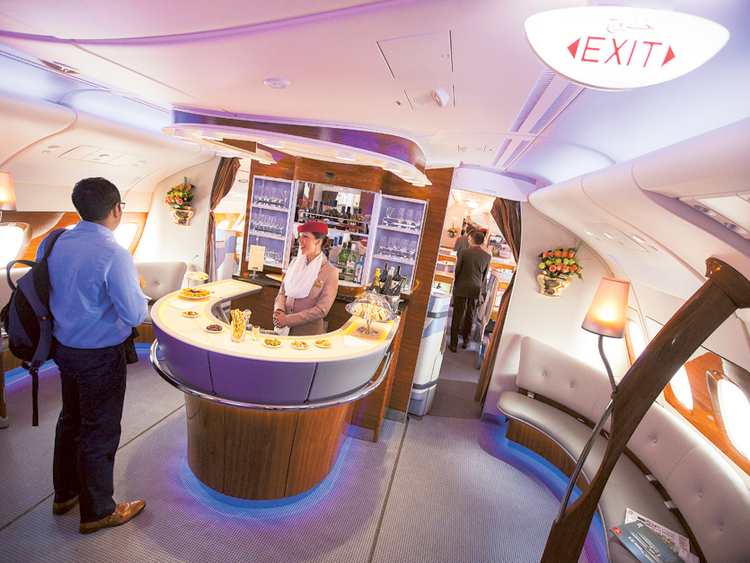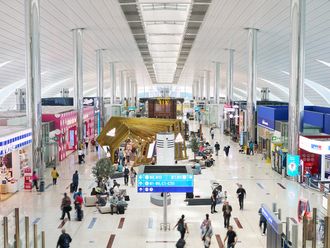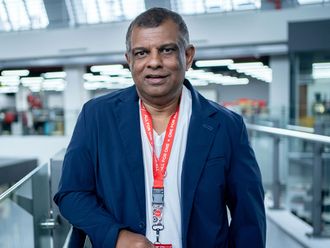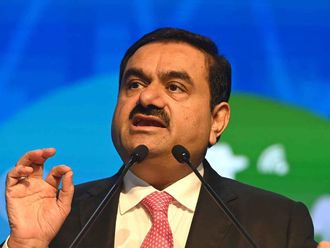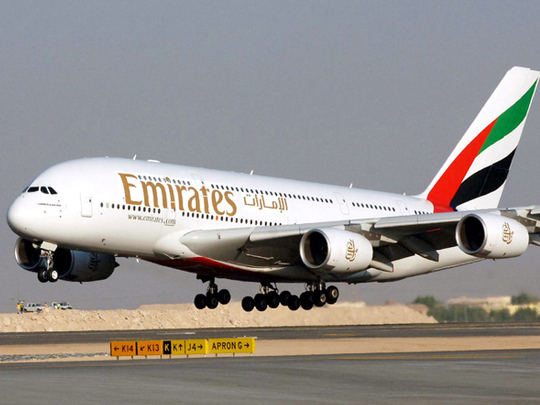
To get a sense of the Airbus A380’s size and ambition, walk up the grand staircase of an Emirates version of the aircraft, go past the showers and the first-class suites and then pass by endless rows in business class to reach the bar at the back of the upper deck. This sleek semicircle, alluringly underlit and fully stocked with pricey spirits like Grey Goose vodka, is undoubtedly one of the defining features of this aircraft, which can hold more than 500 passengers. The plane dwarfs every commercial jet in the skies.
Since it started flying commercially seven years ago, the A380 has caught the imagination of travellers. Its two full-length decks total 6,000 square feet, 50 per cent more than the original jumbo jet, the Boeing 747. Its wingspan barely fits inside a football field. Its four engines take this 560-tonne aeroplane to a cruising altitude of 39,000 feet in less than 15 minutes, a surprisingly smooth ascent for such a bulky plane. Passengers love it because it’s quiet and more reminiscent of a cruise ship than an aeroplane.
The A380 was also Airbus’ answer to a problematic trend: More and more passengers meant more flights and increasingly congested tarmacs. Airbus figured that the future of air travel belonged to big planes flying between major hubs. “More than simply a big aeroplane,” one industry analyst wrote when the first A380 was delivered to Singapore Airlines in 2007, “the newest industry flagship will change forever the way the industry operates”.
The prediction hasn’t exactly come true.
Airbus has struggled to sell the planes. Orders have been slow, and not a single buyer has been found in the United States, South America, Africa or India. Only one airline in China has ordered it, and its only customer in Japan has cancelled. Even existing customers are paring down orders.
Disappointing tally
The A380 has a list price of $400 million (Dh1.5 billion), but the pressure has forced Airbus to cut prices as much as 50 per cent, according to industry analysts. So far, Airbus has received 318 orders and delivered 138 planes to just 11 airlines — a disappointing tally given forecasts that the plane would be a flagship aircraft for carriers worldwide.
Only one airline — Emirates — has made the A380 a central element of its global strategy, ordering 140 as it built a major hub in Dubai. But Emirates is unique. No one else has bet on the plane with quite the same confidence.
The A380 hasn’t done so well for a number of reasons, some merely cyclical. The plane was introduced amid a deep downturn in the airline business. Airline executives were wary of expanding their fleets aggressively, especially for a costly, four-engine fuel hog.
But critics like Richard Aboulafia, an aerospace analyst at the Teal Group, an aviation consulting firm in Fairfax, Virginia, say the main problem is more fundamental: Airbus made the wrong prediction about travel preferences. People would rather take direct flights on smaller airplanes, he said, than get on big airplanes — no matter their feats of engineering — that make connections through huge hubs.
“It’s a commercial disaster,” Aboulafia says. “Every conceivably bad idea that anyone’s ever had about the aviation industry is embodied in this aeroplane.”
Airbus spent roughly $25 billion to develop the aircraft. The plane was delayed for years because of manufacturing problems while Airbus struggled to keep the plane’s weight down and coordinate its complex design among dozens of suppliers across Europe. In 2012, Airbus discovered small cracks in supporting ribs inside the A380’s wings, an embarrassing and costly design error that the manufacturer is correcting.
While the A380 programme has been a boon for the European aerospace industry, Airbus is unlikely to recover its research and development costs. The best it can now expect is to break even on production costs, according to analysts, provided that it can keep orders going.
Steven F. Udvar-Házy, an industry veteran who is chief executive of the Air Lease Corp, which leases aircraft, calls the lack of interest in the planes “a very unusual situation,” especially among US airlines. “I’ve never seen this before in a big program,” he says.
Competing conclusions
A little more than a decade ago, the two dominant airplane-makers, Boeing and Airbus, looked at where their businesses were headed and saw similar facts: air traffic doubling every 15 years, estimates that the number of travellers would hit 4 billion by 2030 — and came to radically different conclusions about what those numbers meant for their future.
Boeing figured that traffic would move away from big hubs and toward secondary airports. So it started to build a smaller, more fuel-efficient long-range aircraft, which became known as the 787 Dreamliner.
Airbus, on the other hand, saw the rise of international traffic through major hubs and decided to bet on a big plane to connect those big airports.
“The A380 is not made for every route, but it is ideal for high-traffic routes, high-volume routes that are congested or where there are flying constraints,” says Antonio Da Costa, the head of A380 marketing for Airbus.
And there are a fair number of those routes. Around 15 of the 20 largest long-haul routes by passenger volume in the world today are slot-constrained, meaning they face some restrictions on the number of daily takeoff or landings, says John E. Thomas, managing director at LEK Consulting, a transportation advisory firm.
Here is one example of how the Airbus theory works in practice: This summer, British Airways plans to replace three Boeing 747s flying each day between London and Los Angeles with two A380s, freeing one slot at Heathrow Airport for another flight.
Lukewarm demand
Yet despite the congestion at hubs like Heathrow and the growth of megacities like New York, New Delhi and Beijing, the market for large planes remains small. Airbus predicts that in the next 20 years, airlines will order more than 29,000 planes from Airbus, Boeing and other makers. But the bulk of those, or roughly 20,000, will be smaller, single-aisle planes that fly routes like New York to Chicago, or London to Frankfurt. Airbus estimates that the market for the biggest — and most expensive — long-range airplanes will be about 1,700.
Boeing, too, is facing lukewarm demand for its latest jumbo jet upgrade, known as the 747-8. The company has received just 51 orders for this big plane, which can seat about 460 passengers and lists at $357 million. By contrast, it has sold more than 1,200 twin-engine 777s, which sell for as much as $320 million. (Airlines typically get discounts on the listed prices.)
More worrisome for Airbus is that it has struggled to find new customers for the A380 after a flurry of initial orders. Just three new carriers — Etihad Airways, Qatar Airways and Asiana Airlines — are getting A380 planes this year. And last month, Airbus cancelled an order for six A380s destined for Skymark Airlines, a low-cost carrier in Japan that has been losing money.
Garuda of Indonesia recently dropped plans to buy the A380, deciding that the plane was too big for its markets. And Virgin Atlantic, which has options for six A380s, remains undecided about whether to proceed. The airline was partly acquired by Delta Air Lines in 2012; Richard H. Anderson, Delta’s chief executive, has said the A380 is “by definition an uneconomic aeroplane unless you’re a state-owned enterprise with subsidies.”
Current customers, too, are cutting back their orders, including the major carriers in France and Germany, where the plane is assembled. Air France postponed the last two of 12 planes it had ordered. Lufthansa has scaled back its order to 14 from 17.
Cooperation of airports
Bruno Delile, Air France’s senior vice president for fleet management, says that there are a limited number of routes in its network with enough daily traffic to justify the expense of such a big plane.
“The forecasts about traffic growth and market saturation haven’t exactly panned out,” he says.
Airlines also have to gain the cooperation of airports to modify gates and widen taxiways to make room for the plane. Apart from the main global hubs, few airports have made these investments. No airport in Brazil, for instance, can handle an A380. The plane was only recently allowed in Mumbai.
“Airports haven’t really been rushing to welcome the A380,” Delile says.
Airbus may have mistimed the market in a more fundamental way. While European engineers were developing the plane, their counterparts at Boeing were working on alternative designs. Out of this effort came the 787 Dreamliner, with a carbon-composite fuselage, a host of electronic systems and more efficient engines that could fly longer distances while consuming less fuel.
That plane, which entered service in late 2011, had its share of high-profile problems; the entire fleet was grounded for three months in 2013 because of battery fires. Boeing says the problem has been resolved, and the company has orders for more than 1,000 of the planes. With versions that seat 210 to 330 passengers, and with a range of about 14,848 kilometres (9,000 miles), the 787 allows airlines to fly pretty much anywhere in the world and connect smaller airports without going through a hub.
Japanese carriers are flying these planes from Tokyo to Dusseldorf, Germany, and to San Diego and Boston. This reduces the need for bigger planes to feed big hubs. And passengers are willing to pay more to avoid a connection, says Will Horton, an aviation analyst at CAPA — Centre for Aviation.
Recognising the success of the 787, Airbus started developing its own version of a long-range, fuel-efficient aeroplane, called the A350-XWB. The first should be delivered to Qatar Airways before year-end. Airlines have ordered 742 of the A350s since the program was announced in 2006.
“No doubt some airlines, given the opportunity to rewrite history, would not order the A380,” Horton says.
A bar in the sky
The view from Tim Clark’s office on the top floor of the Emirates headquarters in Dubai offers a stunning panorama of the city’s airport, including a new $4.5 billion terminal. Emirates operates 50 A380s, with more on the way, and has built its business model around the plane. Traffic here never stops. Even at midnight, when flights from the east land and connect passengers who are headed west, the airport is alive and bustling.
If most airlines appear sceptical of the A380, Emirates is a true believer. It stunned the industry in December when it ordered 50 more of the planes, beyond the 90 it already had on order, throwing Airbus a much needed lifeline. (Emirates also ordered 150 new Boeing 777Xs, a more efficient variation on the best-selling jet, helping to initiate the programme for this new aeroplane, due in 2020.)
Clark, the president of the airline, has turned it into one of the world’s largest carriers by seat capacity. And he is the A380’s most enthusiastic supporter.
“People get on the A380 and they absolutely love it,” he says. The upper deck on the Emirates version, he adds, is “just one big party”.
The son of a tanker ship captain and an economist, Clark joined Emirates in the mid-1980s. His basic insight about the A380 is simple: It can be a canvas for a new kind of luxury flight experience. It was Clark who came up with the idea to install two showers for first-class passengers. Airbus engineers thought the idea was crazy because it would require more fuel to fly the water for the showers. But he dismissed their objections. The showers would immediately distinguish the plane from anything else in the air.
He also put a large bar on board, along with a pair of semicircular couches, equipped with seat belts in case of turbulence.
“This thing is so popular and during the course of a 14-hour flight it becomes even more popular,” he says. “They all want to have their picture taken behind the bar with their arms around the girls,” he says, referring to passengers posing with the flight attendants.
Cheerful mood
That was certainly the atmosphere on a 13-hour flight between New York and Dubai earlier this year. While about 400 weary coach passengers on the lower deck tried to catch a few hours of fitful sleep, the upper-deck mood was more festive.
Rudolph V. Pino Jr, an insurance lawyer from New York, enjoyed a glass of chardonnay and traded pleasantries and business cards with other passengers. The bar was staffed by cheerful flight attendants amid an endless supply of drinks.
“It’s a special aeroplane,” he said. “It brings some glamour back to air travel, just like in the days of TWA and the old Boeing 747s.”
Unlike airlines in the United States, Emirates, which is a product of Dubai’s aviation-friendly policies, operates from a single hub. The airport handled 66 million passengers last year, rivalling Heathrow as the busiest international hub. Emirates serves more than 140 destinations, essentially connecting flows of passengers with a single stop in Dubai.
But for Emirates, the biggest selling point of the A380 is its ability to pack in more business-class seats and create an environment that appeals to big-spending passengers.
“The upper deck of the A380 is an absolute gold mine for us,” Clark says. “We elected to make it all premium. We elected to put in all the gadgets and gizmos. We were laughed at, at first.”
There are more first- and business-class seats on the Emirates A380 than on the 777, and they are usually 75 to 80 percent full, Clark says. On some routes, like those to Heathrow, where Emirates has five daily flights, that figure can reach 90 per cent. Once the whole plane is 85 per cent full, its operating costs fall below those of a 777, he says.
Expensive gamble
It’s a simple-enough recipe. But for the plane to be successful for Airbus, Emirates can’t be the only airline to make it work.
“United would be a great operator from San Francisco to Asia,” says Mark Lapidus, chief executive of Amedeo, an aircraft leasing company. Last year, Lapidus announced that his company would buy 20 new A380s, in a deal valued at $8.3 billion, and then lease them to airlines. It was an expensive gamble, and Amedeo doesn’t have any commitments yet.
The problem is that US carriers, including United, aren’t interested. Wall Street analysts aren’t convinced, either. Shares of United would plunge at least 10 per cent if it bought A380s, according to one analyst, because of concerns that they would bring too much capacity into the market.
In recent years, US airlines have found the way back to profitability by cutting capacity and retiring airplanes, effectively taking seats out of the market. A bigger plane, in the view of some analysts, would undo everything they’ve done.
Some analysts are also worried about the resale value of an A380, once the planes come off their lease and enter the secondary market. With weak sales and limited interest today, aviation experts say, the plane’s resale value could potentially depress new A380 prices even further.
In his aerie in Dubai, Clark appears untroubled by these considerations.
Clark has repeatedly said he would buy more planes if Airbus could deliver them fast enough.
“My view is that we’ve all got to tough this out,” he says. “As I say to my friends at Airbus: Don’t bottle this. The day will come again. The global economy will take care of you.”
He has encouraged Airbus to build an even bigger version of the A380. That, even Airbus would concede, seems unlikely.


